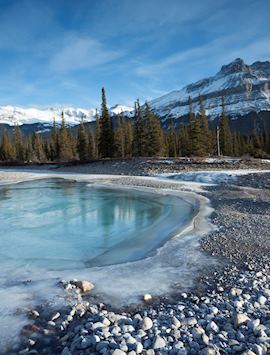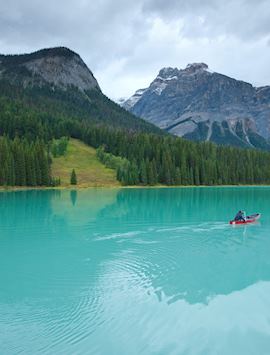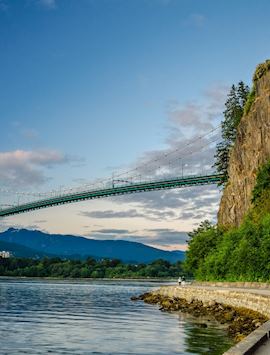By Canada specialist Grace
From sun-soaked lakes to forests awash with snow, Alberta casts a striking image, no matter the season. After living there for two years, I can recommend visiting its glaciated mountains, turquoise waters, and infinite-seeming prairies all year-round.
That said, the province’s versatility can make it all the more difficult to decide when to go. Each of the four distinct seasons appeals in its own way — it just depends where your passions lie. To help you narrow it down, I’ve shared some of my highlights for spring summer, autumn, and winter, from adrenaline-filled snow sports to easy-going city stops.
Alberta in spring
From March through to late May, Alberta is mid-metamorphosis. Golden sunlight bathes the valleys, the glacial lakes start to thaw to emerald green, and residents finally put the more excessive parts of their winter wardrobe to rest for another year.
But, it isn’t quite the end of the winter scenery. The mountains stay blanketed in powdery white, especially at higher altitudes, and the basins below are a mishmash of icy sheets and newly sprouted wildflowers.
Explore Banff National Park by helicopter

As a keen photographer, I was always on the hunt to document this harmonious coexistence of snow and spring, and in my opinion, the best way to capture it is from above.
My go-to journey through the Albertan skies is by helicopter from Canmore. It starts above the Three Sisters, a trio of ice-striped peaks that tower over a valley festooned with pine trees. You then soar over the snow-speckled meadows of Banff National Park. If you have more time, you’ll hover above the turquoise waters of Marvel Lake, too.
For further adventure, your pilot can drop you off at an alpine meadow from which you can hike to the top of these peaks, taking in the vistas of the snow-laden slopes below. It makes for an ideal time to spot bears from a safe distance. Just emerging from hibernation, grizzly bears are most visible during late April to early May, when the valleys are devoid of crowds but flush with sedge grasses.
Find fossils in the Badlands
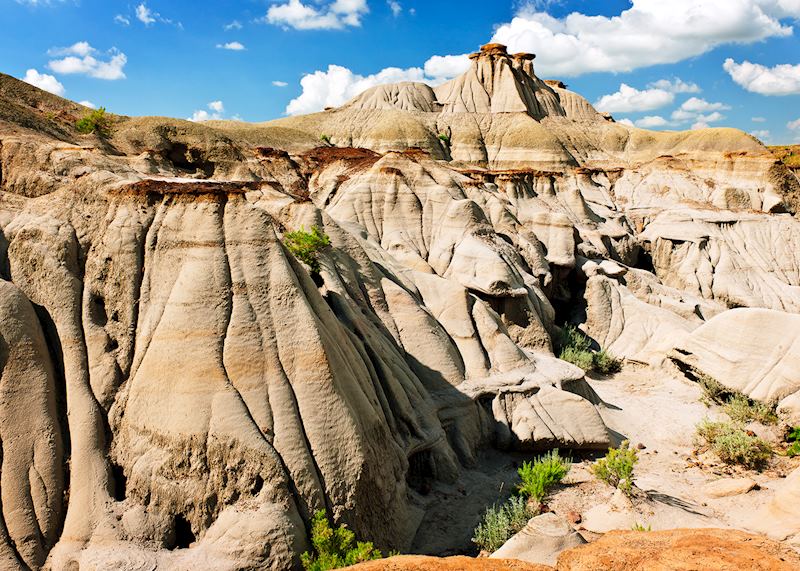
Spring sees less rain than the rest of the year in Alberta, and its electric-blue skies mean it’s a great time to be outdoors.
Though many of the trails around the Rockies aren’t open until June, you can visit the Badlands, about a two-and-a-half-hour journey from Calgary, all year round. By May, the russet canyons of the area are dotted with mossy greens.
This primeval setting, where striated hoodoos stretch to the horizon, is known as the ‘dinosaur capital of the world’. Home to Dinosaur Provincial Park, here you can walk across undulating hills to see a near complete dinosaur skeleton lying in situ.
To learn more about the latest in paleontological discoveries, you might also want to check out the Royal Tyrrell Museum in Drumheller, which boasts a record-breaking dinosaur collection, as well as interactive displays and exhibits for all ages.
Catch an ice hockey game in Edmonton
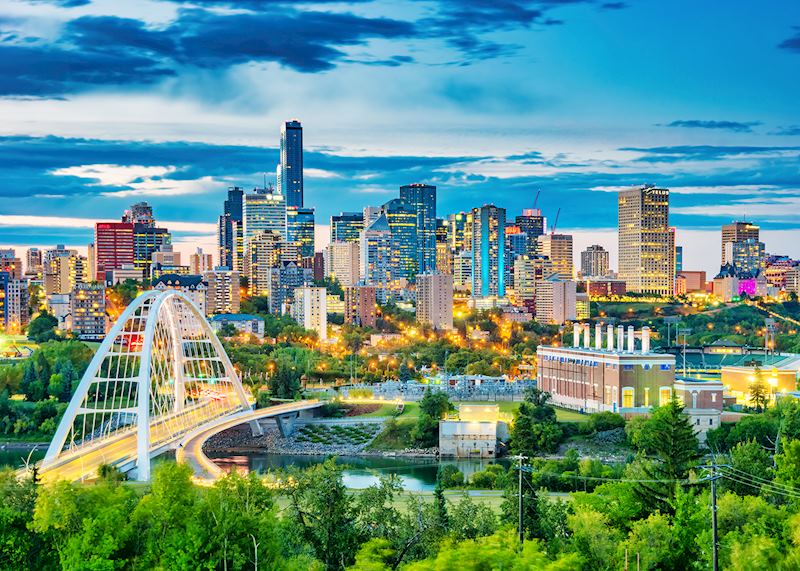
Though the weather around the Canadian Rockies is perennially variable, Alberta’s cities are typically crisp and dry in the spring months, making them an ideal pitstop between nature trails.
In mid-May, Edmonton’s farmers markets open. Strolling around these is my favorite way to try out the fresh fare of the prairie provinces, from tangy sweet rhubarb to earthy asparagus.
For a quintessentially Canadian experience, however, spring is also a golden time to check out the ice hockey. The National Hockey League (NHL)’s regular season runs until April, and whenever I’d visit the city, I loved to catch the Edmonton Oilers, Canada’s second-most decorated team, play on home turf. I recommend watching a game with a hot dog and Bloody Caesar (Canada’s answer to the Bloody Mary) in hand.
Learn about Indigenous culture at Métis Crossing
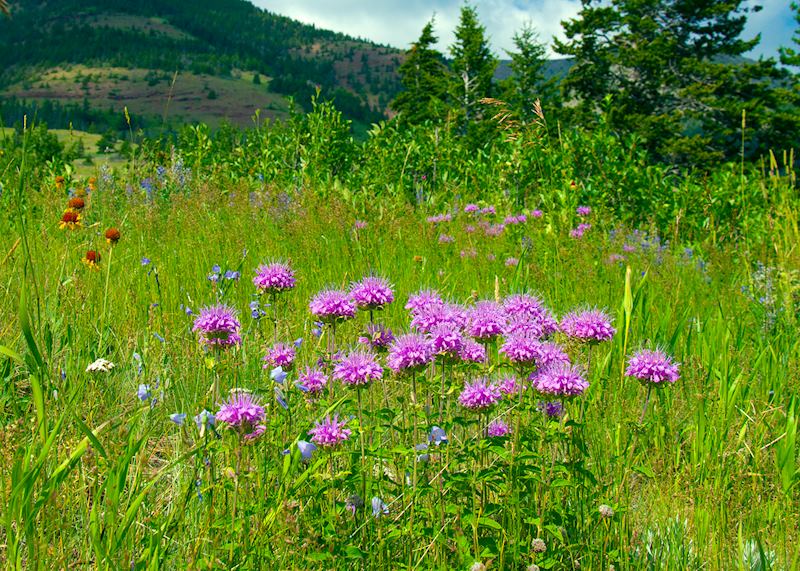
Drive for an hour and a half from Edmonton, through the Albertan east’s vast wildflower-strewn prairies, and you’ll reach Métis Crossing. Here, you can get to know the Métis — a post-contact Indigenous Nation arisen from the union of European fur traders and First Nations peoples in the 17th century.
Though open year-round, the educational facility offers a variety of new workshops and exhibits in spring, all on the grounds of the original river lots built by the Métis settlers. As the snow starts to melt, you can also get out onto the outdoor trails, where you might spot bison, elk, or Percheron horses roaming in the coulees.
Seasonal tips for Alberta in spring
The beauty of spring is that it captures the best of both worlds — Alberta in winter and summer — while being significantly quieter and less expensive than those other seasons.
For me, this means double the activities (when I lived there, I would ski in the morning and rock climb in the afternoon). But, if one climate holds your interest more than the other, I recommend booking either earlier or later in the season to avoid disappointment.
The snow is at its most powdery in early March, while most of the lakes have melted by the end of May. Many of the snow-related activities also cease at around the same time.
Alberta in summer
In summer, Alberta explodes with natural wonders worthy of glossy guidebook photo spreads: the brilliant aquamarine lakes, the fields thick with wild roses and lupine, and the towering pine forests where moose and mountain lions dwell.
Yet, while scenery may be at its most dazzling from June to August, it also comes with immense footfall. Luckily, there are ways you can still soak up the atmosphere while escaping the masses.
See Lake Louise & Moraine Lake at dawn
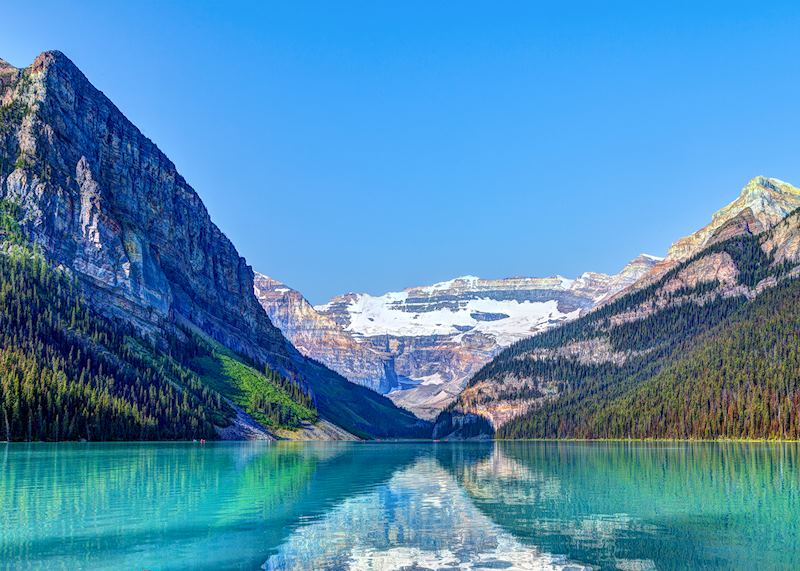
Lake Louise and Moraine Lake are without a doubt the most visited attractions in the Rockies — and for good reason. These vast glacial pools, which vary from bright cerulean to deep cobalt blue, are an intense feast for the senses. Cradled within larch-brimmed valleys, on sunny days, they reflect the surrounding timeworn mountains on their sparkling surfaces.
When I lived in the area, the local tip was to reach these valleys before sunrise, both to steer clear of the larger crowds and to watch the sunlight creep gently up the mountainside. This has become significantly harder since the road to Moraine Lake closed to private vehicles in 2023, but you can still reach the lake by dawn on an early-bird tour.
Now only accessible to limited tours and guests at Moraine Lake Lodge, the lake at sunset is even more tranquil than ever before. I’d take advantage of this quietude by walking one of the hiking trails around the lake, and listen out for the chirps of the birdlife nesting in the pine trees.
Spot wildlife at Jasper National Park
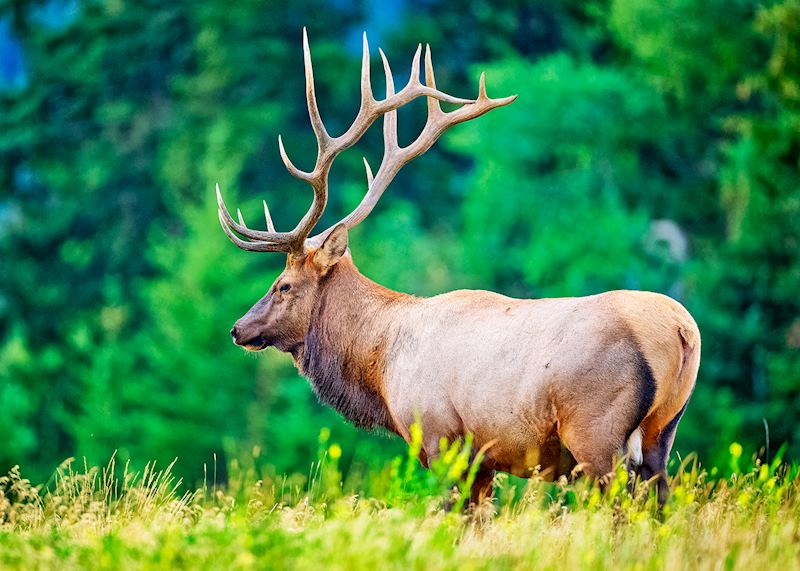
Banff National Park may house Alberta’s best-known lakes, but don’t discount its other national parks too quickly. For me, Jasper National Park, a three-and-a-half-hour drive north and twice the size of Banff, is the place to be for those rarer wildlife sightings.
Muscular caribou, fluffy-coated mountain goats, wily red foxes, and even a small family of wolves — I’ve seen them all on summer hikes in Jasper.
A plethora of wildlife tours are offered of the park, but few guides are as knowledgeable — or as enthusiastic — as Joe, a local Métis guide who has been living among the mountains for more than 20 years.
On his tour, you’ll amble the quieter corners of the Athabasca Valley, past serrated-looking gorges and rushing river waters, in search of bears, elk, and whatever else might be present at the forest edge. All the while, you’ll learn about the ecosystem that supports the Albertan wildlife, as well as hear stories about the Métis Peoples and their history in Jasper.
Watch a rodeo at Calgary Stampede
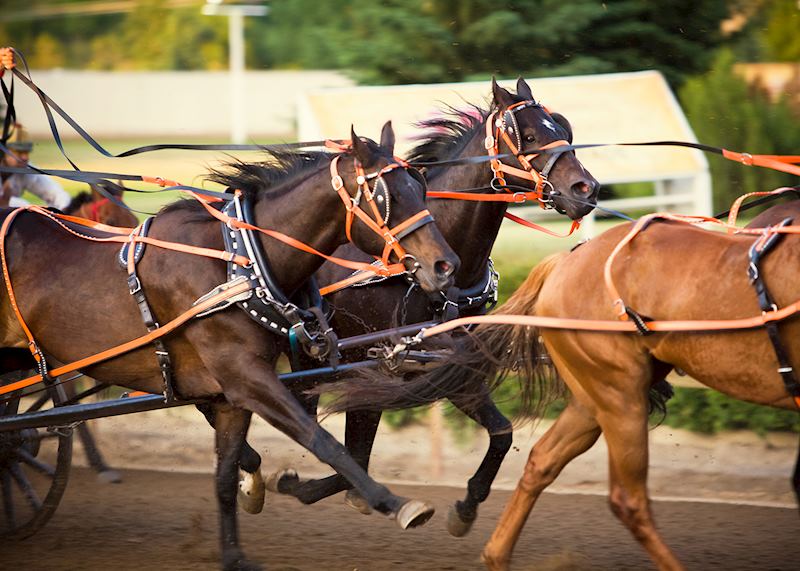
There are plenty of events going on in Alberta in summer, but none quite as exhilarating as Calgary Stampede. This ten-day event in mid-July is the world’s largest rodeo. People flock from all over the world to experience its hair-raising chuckwagon races, star-studded evening shows, and culture-showcasing parades.
Even if you don’t consider yourself much of a cowboy, there’s more than enough to do here for the casual visitor, from exhibitions on sustainable practices to some of the most surprising treats you’ll ever eat (think deep-fried bubble-gum and cricket grilled cheese).
Though, I do recommend getting yourself a cowboy hat if you want to fit in. The streets of Calgary become awash with plaid shirts and white wide-brimmed Stetsons — not to mention every size, shape, and shade of horse you can imagine — when the Stampede’s in town.
Seasonal tips for Alberta in summer
Alberta’s summer sun draws in heaves of crowds, so to circumvent the congestion, consider a trip in September instead. This was my optimal time to go hiking in the Rockies. You’ll still be able to experience the reflective lakes before they freeze, and you may even catch the start of the leaves changing (weather depending).
Alberta in autumn
Bright yellow meadows, vivid red wild rose bushes, mountains blanketed with amber larch trees — for a short period from mid-September to early October, Alberta becomes a fruit bowl of fall foliage. I also find the trails are much quieter.
Hike Waterton Lakes National Park
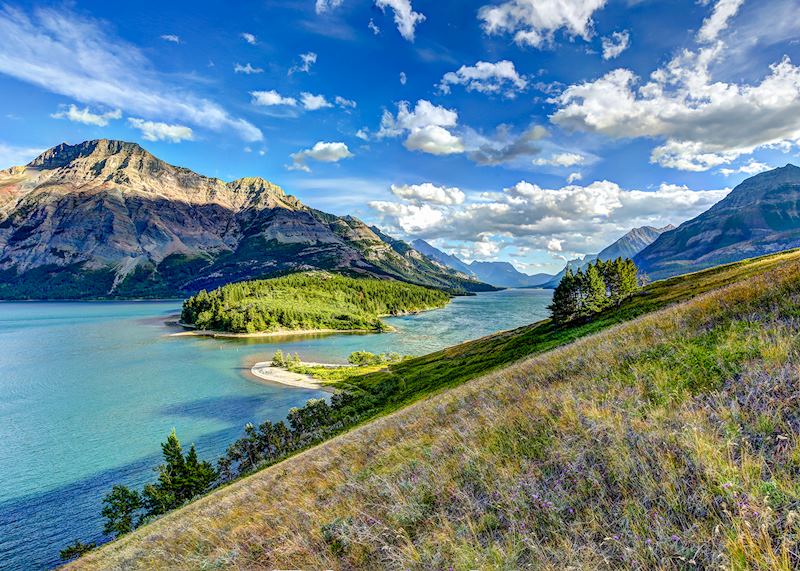
For me, this is an opportune time to explore the Rockies. The humidity is considerably lower than in summer, leading to moments of crystal-clear skies on almost all days. It’s the sort of weather that’s just begging for you to lace up your walking boots.
My preferred hiking spot during this period is Waterton Lakes. Lesser known than Alberta’s other national parks, this quieter spot sits at the junction between its windswept prairies and the foreboding eastern edge of the Rocky Mountains.
On the park’s walking trails, you wander by sections of the various crystalline Waterton Lakes. While hiking, I used to love to stop and look in from the water’s edge, watching the speckled rainbow trout graze the surface. And, if you visit late enough in the season, you just might catch the geese gathering en masse by the lakeside, preparing for their migration south.
Cruise across Maligne Lake
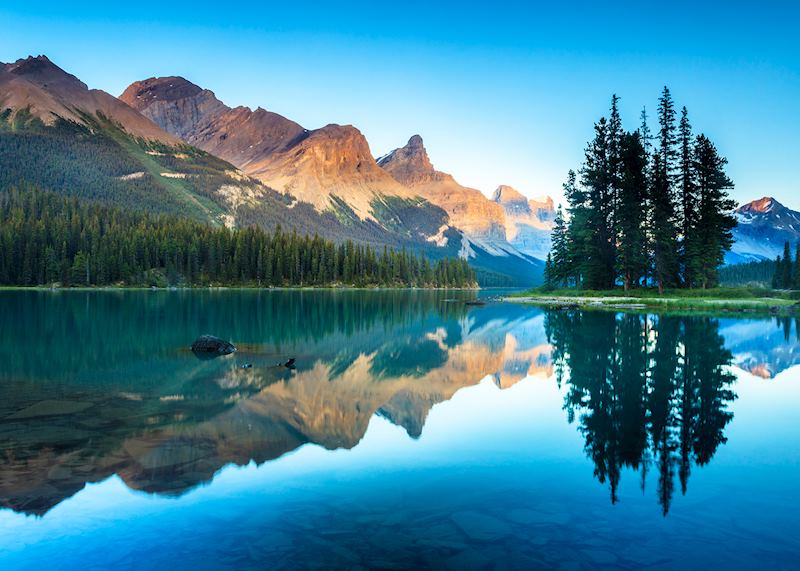
Of course, hiking isn’t the only way to experience Alberta’s autumnal hues. During the first of October, you can speed past glaciated peaks and dense golden larch forests on a cruise of Maligne Lake.
My most photographed spot in Jasper National Park, the teal waters of the lake are fed by the foaming runoff of the surrounding glaciers. You can learn about this unusual geology — and capture moments of your own — on the cruise while you journey to Spirit Island.
Barely the size of a bus stop, Spirit Island is the pinnacle of the cruise found at roughly the midpoint of the lake. It’s a serene spot where, if the waters are low enough, a variety of animals gather. During my last visit there, on a crisp September morning, I was fortunate enough to watch as an eagle glided in and around the islet’s pine trees.
Go horse riding at Sulphur Mountain
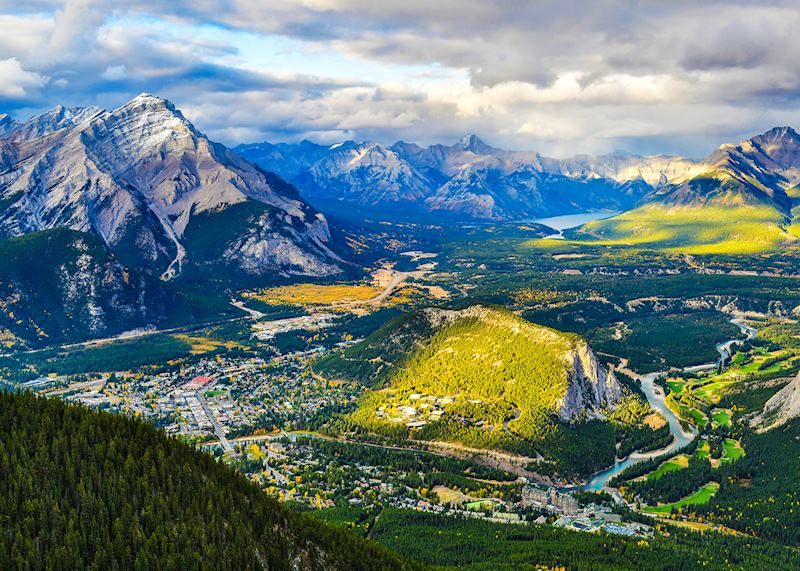
Though Alberta may be a fair bit chillier in autumn, by making sure you wear plenty of layers, there are still lots of activities you can take part in. Horse riding experiences, for instance, are typically available until late October.
I’m a huge animal lover but not much of an experienced rider, so the gentle route around Sulphur Mountain is ideal for me. On this trek around the Bow Valley’s thick marshes, you ride to bubbling hot springs and along the pebbled banks of the Bow River, before heading up Sulphur Mountain itself.
At the aptly named Windy Knoll, you’ll find sprawling views of Banff National Park’s fir forests below you, with the Rockies’ white-capped pinnacles reaching out past the horizon.
Afterwards — if you’re anything like me — the mountain air will have helped you work up an appetite. Fortunately, there’s an abundance of restaurants you can visit in Banff, typically in charming chalet-style buildings. Autumn is an excellent time to check out the usually busy resort town, as fewer visitors mean you can wander around at a more leisurely pace.
Seasonal tips for Alberta in autumn
Alberta’s autumn leaves are temperamental at best and only stick around for a very brief three to four weeks. However, you’ll usually see the leaves start to turn by the second week of September and reach their peak by early October.
By mid-October, most will have fallen, but this also makes it one of the best-value times to visit the province. Not all of the autumn activities will have finished for the season just yet and you’ll still be able to enjoy relatively mild weather.
Alberta in winter
I keep it no secret that Albertan winters hold a special place in my heart. To me, they evoke a sense of frozen majesty. Think icy tendrils climbing up thick deciduous trees, frigid lakes like polished mirrors, and snow-mantled peaks beneath steely blue skies.
From November to February, the Rockies, in particular, come to life with an array of winter activities. I’ve mushed with Malamutes, explored icebound waterfalls, and sipped champagne at an outdoor ice bar, but a few activities stand out from the rest.
Ice walk through Maligne Canyon

Alberta frequently shatters records as one of the coldest places on Earth, reaching temperatures as low as minus 40 C (minus 40 F) in mid-January. Beautiful though it may be, it’s important to be prepared and wrap up warm. (Learn more about how to do this in our practical guide to winter in Canada).
You can best see the effects this weather has on the environment at Jasper National Park’s Maligne Canyon. Here, you can don ice cleats (also known as crampons) to walk a frozen creek bed, passing by crystalline waterfalls, frosted limestone karsts, and bright blue waters still not yet fully iced.
The brave can also slither into some of the cave cracks and explore behind the waterfalls, or carpet-slide down the icy slopes.
My highlight of the experience, however, is the sense of stillness it instills in you. As you walk, the dry cold of the canyon causes little icicles to form on your eyelashes. You can see your breath become a wispy cloud. It’s as if you become part of the atmosphere and the whole process is meditative.
Try ice climbing at Tangle Falls
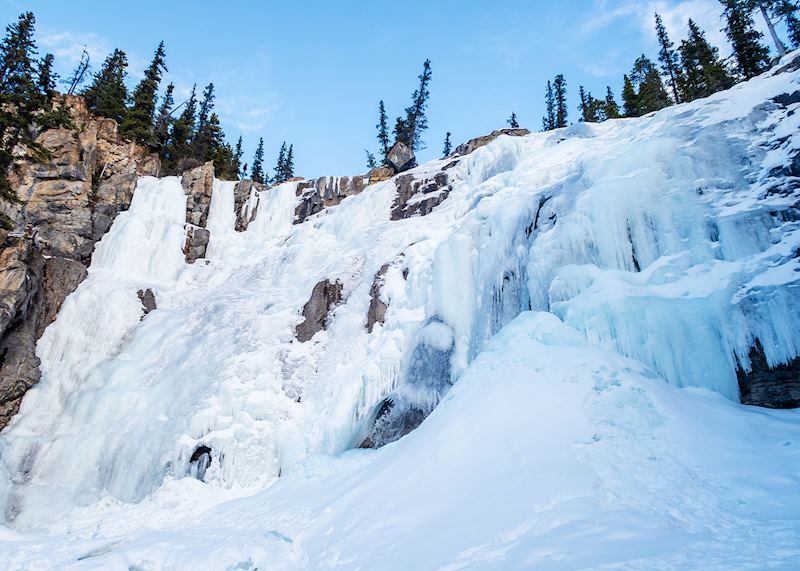
I’m a bit of thrill seeker, so once I’d done my fair share of ice walks in Alberta, I knew I needed to find something even more challenging. This was when I discovered ice climbing, the act of using axes and ropes to ascend a frozen waterfall.
You can ice climb — alongside a professional guide who can (literally) show you the ropes — at a number of locations across the province. In fact, the aforementioned Maligne Canyon is a popular spot. But, I’m a big fan of Tangle Falls, a little further south in the park. This multi-tiered waterfall is surrounded by frost-dappled pine trees, and once you reach the top you can see for miles over the forested valleys of the park.
If you’re staying in Jasper, you will be driven to the falls via the Icefield Parkway. This scenic drive, widely stated as one of the most beautiful in the world (and I quite agree), cuts through valleys of glacier-clad mountains, with deciduous woodland continuing off into the distance.
Take a sleigh ride around Lake Louise
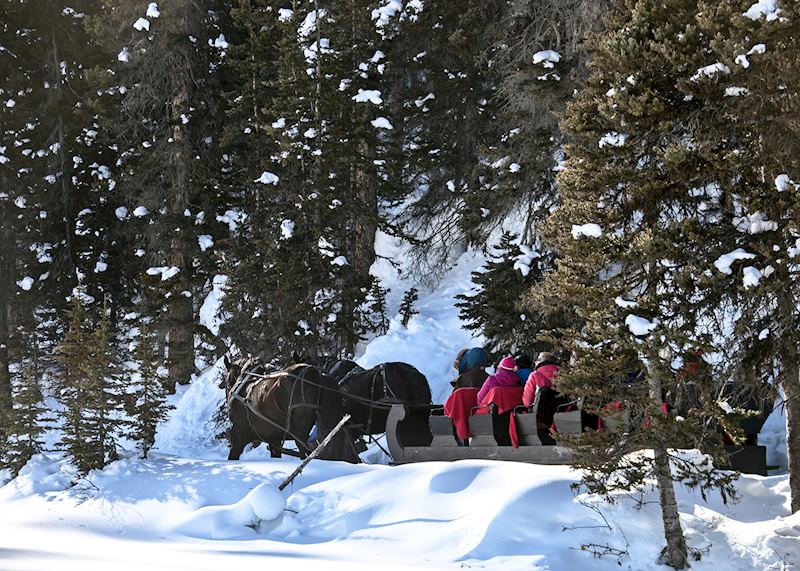
For those who prefer a snugglier approach to winter, there’s plenty to do around the lake resorts. You could enjoy a stay at Fairmont Château near Lake Louise, one moment ice skating the frozen waters and the next heading to Fairview Restaurant for afternoon tea.
A horse-drawn sleigh ride around the lake trail is another more comfortable option. This 45-minute experience takes you right up to Victoria Glacier. Romantics will enjoy the evening ride, where you can snuggle up beneath star-studded skies. Afterwards, you head back to the stables for a hot beverage and gooey chocolate s’mores.
Explore the city of Calgary

With the Rockies as striking as they are, it’s easy to forget about the Albertan cities in winter, but there’s still plenty to do in Calgary during the snowier months.
Sports fans may recall Calgary 1988, the Winter Olympics that saw the debut of the Jamaican national bobsleigh team and British ski jumper ‘Eddie the Eagle’. At WinSport Canada Olympic Park, you have the opportunity to learn more about this famous event. Ice skating, luge, bobsleighing, and cross-country skiing are also offered during the winter months.
Meanwhile, music connoisseurs can walk the Canadian Music Hall of Fame and learn about Calgary’s connection to country music at Studio Bell. And, for more music and festivities, check out Chinook Blast, a six-week-long festival that takes place in mid-February each year.
Last time I was there, I had a big juicy Alberta steak burger, followed by the most Alberta of desserts: hot taffy poured onto the snow to make a frozen popsicle.
Seasonal tips for Alberta in winter
If, like me, you’re used to a more temperate climate, the best time to visit Alberta in winter is late February or March. The winds will be a little less biting and the slopes powdery as opposed to icy.
Read more about trips to Alberta, Canada
Start thinking about your experience. These itineraries are simply suggestions for how you could enjoy some of the same experiences as our specialists. They're just for inspiration, because your trip will be created around your particular tastes.
View All Tours in Canada
